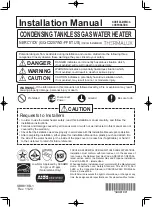
24
Anode Rod/Water Odor
Each water heater contains at least one anode rod, which
will slowly deplete while protecting the glass-lined tank
from corrosion and prolonging the life of the water heater.
Once the anode is depleted, the tank will start to corrode,
eventually developing a leak. Certain water conditions will
cause a reaction between this rod and the water. The
most common complaint associated with the anode rod
is a “rotten egg smell” produced from the presence of
hydrogen sulfide gas dissolved in the water. IMPORTANT:
Do not remove this rod permanently as it will void any
warranties. The parts list includes a special anode that
can be ordered if water odor or discoloration occurs.
NOTE: This rod may reduce but not eliminate water
odor problems. The water supply system may require
special aeration or chlorination equipment from a water
conditioning company to successfully eliminate all water
odor problems.
The use of a water softener may decrease the life of the
water heater tank.
The anode rod should be removed from the water heater
tank every 3 years for inspection. The following are typical
(but not all) signs of a depleted anode rod:
•
The majority of the rods diameter is less than 3/8”.
•
Significant sections of the support wire (approx. 1/3 or
more of the anode rod’s length) are visible.
If the anode rod shows signs of either or both it should be
replaced. NOTE: Whether reinstalling or replacing the
anode rod, check for any leaks and immediately correct if
found.
In replacing the anode:
1. Turn off gas supply to the water heater.
2. Shut off the water supply and open a nearby hot water
faucet to depressurize
the water tank.
3. Drain approximately 5
gallons of water from
tank (Refer to the
“Draining and Flushing”
section for proper
procedures). Close drain
valve.
4. Remove old anode rod.
5. Use
Teflon
®
tape or
approved pipe sealant
on threads and install
new anode rod.
6. Turn on water supply
and open nearby hot
water faucet to purge
air from water system.
Check for any leaks and
immediately correct any
if found.
7. Restart the water heater as directed under the
“Operating Your Water Heater.” See the “Repair Parts
Illustration” section for anode rod location.
TEFLON
®
is a registered trademark of E.I. Du Pont De Nemours and Company
Draining and Flushing
It is recommended that the tank be drained and flushed every 6
months to remove sediment which may build up during operation.
The water heater should be drained if being shut down during
freezing temperatures. To drain the tank, perform the following
steps:
1. Turn off the gas to the water heater at the manual gas shut-
off valve.
1. Move the switch on the gas control valve/thermostat to the
“OFF” position to turn off the water heater.
2. Open a nearby hot water faucet until the water is no longer
hot.
3. Close the cold water inlet valve.
4. Connect a hose to the drain valve and terminate it to an
adequate drain or external to the building.
5. Open the water heater drain valve and allow all of the water
to drain from the tank. Flush the tank with water as needed to
remove sediment.
6. Close the drain valve, refill the tank, and restart the heater as
directed in this manual.
If the water heater is going to be shut down for an extended
period, the drain valve should be left open.
IMPORTANT:
Condensation may occur when refilling the tank
and should not be confused with a tank leak.
.
Routine Preventive Maintenance
At least annually, a visual inspection should be made of
the venting and air supply system, piping systems, main
burner, pilot burner, and flame-arrestor. Check the water
heater for the following:
•
Obstructions, damage, or deterioration in the venting
system. Make sure the ventilation and combustion air
supplies are not obstructed.
•
Clean any dust or debris from the base-ring filter.
•
Soot and/or carbon on the main burner and pilot
burner. Contact a qualified technician.
•
Leaking or damaged water and gas piping.
•
Presence of flammable or corrosive materials in the
installation area.
•
Presence of combustible materials near the water
heater.
•
After servicing this water heater, check to make sure
it is working properly. (See “Operating Your Water
Heater” section of this manual.)
IMPORTANT: If you lack the necessary skills required to
properly perform this visual inspection, you should not
proceed, but get help from a qualified technician.
EXPOSED
SUPPORT
WIRE
PITTED
ANODE
ROD
EXPOSED
SUPPORT
WIRE
FIGURE 24.
















































